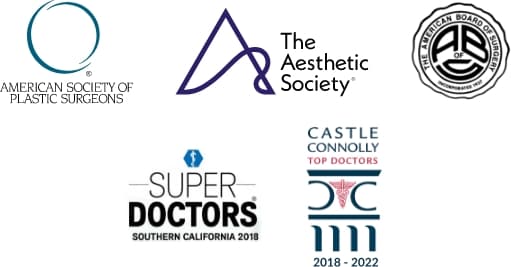Dr. Richardson and Dr. Memsic are two of the top breast surgeons in Los Angeles, using innovative techniques to create excellent clinical and aesthetic outcomes.
Schedule a Visit
Bedford Breast Center
436 N Bedford Dr, Ste 308
Beverly Hills, CA 90210
Phone: (310) 278-8590
Monday – Friday: 9 a.m.– 5 p.m.
Breast Self-Exam
Mammograms can detect cancer before you can feel a lump, but breast self-exams familiarize you with how your breasts look and feel so you can alert your healthcare professional to any changes.
Forty percent of diagnosed breast cancers are first detected by women who feel a lump. At Bedford Breast Center, we recommend monthly breast self-exams for all our Los Angeles, Beverly Hills, Santa Monica, Glendale, and Malibu-area patients as a valuable means of early detection.
What Is a Breast Self-Exam?
The first step in breast cancer screening should be breast self-exams: a visual and physical inspection of your breasts to check for changes or problems. Becoming familiar with the look and feel of your breasts allows you to differentiate between normal and abnormal findings during your self-exam.
Breast self-exams are easy to do and can be done in minutes in the comfort of your own home. They are usually performed while standing or lying down.
During your self-exam, pay attention to the following:
- Size
- Shape
- Skin color
- Swelling
- Dimpling
- Puckering
- Lumps
- Nipple inversion
- Nipple discharge
Changes in the breasts can be normal. Lumpy, bumpy breasts can also be normal. Most lumps, bumps, and breast changes do not indicate cancer. In fact, according to the American Cancer Society, even most biopsy results are not cancer.
Breast changes can happen for many reasons: menstrual cycles, birth control pills, pregnancy, aging, and menopause. Routine breast self-examination is one of the best ways to detect breast changes. Get to know your breasts so you can identify what is normal for you and what is not.




How Often Should I Do a Breast Self-Exam?
Routine breast self-exams should be performed once a month by all women—especially women in their 20s and 30s who are not undergoing regular mammography screenings. The best time is approximately 3 to 7 days after the first day of your period when the breasts are less tender and lumpy during your monthly cycle. Try to perform your self-exam at the same time every month.
Your healthcare provider should conduct a clinical breast examination annually, and women over age 40 are encouraged to have a mammogram yearly. More frequent screenings are necessary for women at a higher risk due to family history or other factors.
How To Perform a Breast Self-Exam
Breast self-exams should be done in several ways to ensure you get a complete visual and physical inspection of all breast tissue.
When performing a breast self-exam, it is helpful to follow specific patterns to ensure that all areas are getting inspected. For any pattern, whether a circular motion or straight lines across the breast, it is best to have your fingers move in tiny circles. Move your fingers in an overlapping circular motion, making sure that all parts of your breast are covered.
Feel all the tissue from the collarbone down to the bra line and from the armpit to the breastbone. Be firm but gentle, and examine each area with 3 levels of pressure. Start by using soft pressure to feel the tissue closest to the skin’s surface. Increase to medium pressure to probe deeper, then apply firm pressure to feel the deepest tissues, especially those near the breastbone and ribs. Then squeeze the nipple, checking for discharge.
Most breasts have some lumps or thick tissues. Be more attentive to lumps that are harder than other parts of your breast or unusual to your touch. If you notice changes or have any concerns, see your doctor as soon as possible.
In Front of the Mirror
First, start by undressing from the waist up, placing your arms at your side or your hands on your hips. Visually examine your breasts in the mirror. Check that both breasts are their usual size, shape, and color. Look for any unusual swelling or coloration, changes in the skin’s texture, changes in the nipples, or lumps. Next, while still in front of the mirror, place both hands on the back of your head and visually inspect your breasts in this position.
Sitting or Standing
Start by raising your right arm and placing your hand on the back of your head. This helps to provide tension to the chest wall. You need to check the whole breast from the armpit down to the bra line. With the left hand, using the pads of the 3 middle fingers (index to ring finger), move around your entire breast in a circular pattern from the outside to the center. Check the entire breast and armpit area for lumps, thickening, or hardened knots. Then do the same to the other breast.
Some women prefer to do this in the shower because it allows the fingers to slide easier across the breast tissue. You can also use lotion if you do not want to do your self-exam in a shower.
Lying Down
When lying down, the breast tissue spreads out evenly along the chest wall. Start by lying down, raising your right arm above your head, and placing a pillow under your shoulder. With your left hand, feel the entire breast and surrounding area, from the collarbone down to the bra line and the armpit inward to the space between the breasts.
It is important to check the surrounding areas because breast cancer can be found in nearby lymph node tissue and under the arm. Feel for any lumps or thickening of the breast tissue. Notice if a lump persists, worsens, or becomes more evident over time. Repeat this process for the left breast using your right hand.
To find out more information on how to perform a breast self-exam, please visit mayoclinic.org.


- No Compression - Comfortable, pain-free imaging
- Open Design - Won't trigger claustrophobia
- Ideal for Dense Breasts - Advanced detection with contrast
- Fast Results - Complete scan in under 10 minutes
Vera Scan with contrast provides enhanced detection comparable to MRI, delivering precise, accurate diagnosis in a fraction of the time.
Call (310) 278-8590 to reserve your appointment.
Is Vera Scan Right For You? Take The QuizCan I Rely on Breast Self-Exams Alone?
Breast self-exams are not intended to replace conventional breast screening methods, such as clinical exams or mammography, which can detect tumors before they can be felt. Breast self-exams can help you know what is normal for you. Being familiar with the normal look and feel of your breasts can alert you to the need to visit the doctor.
Your healthcare provider will assess your risk. With this knowledge, they may order more frequent mammograms, ultrasound, or MRI images. Early detection is the key to curing cancer, which is why we focus on providing the most effective breast cancer screening available. If a tumor is discovered before it has moved to other areas of the breast or body, there is a much greater chance that it can be eradicated.
Finding A Lump In Your Breast
Finding a lump in your breast during a self-exam can be alarming. What you need to know is that most breast lumps are benign. Many causes are associated with breast lumps or masses, ranging from simple fluid-filled cysts to other forms of noncancerous breast disease. For this type of non-cancerous, benign lump, we offer the MILR: a quick, in-office, non-surgical lump removal.
All breast lumps should be checked out by a breast specialist. If the lump is benign, it is excellent news and will provide peace of mind. If it is cancer, you will have caught it early and likely be cured. If you’re asking yourself, “What do I do if I find a lump in my breast?” the answer is to have it checked by a breast specialist at Bedford Breast Center.
Our world-class facility serves patients from throughout Los Angeles, Southern California, and nationwide. To learn more about breast self-exams, call us at (310) 278-8590 or contact us using the online form to schedule an appointment.
